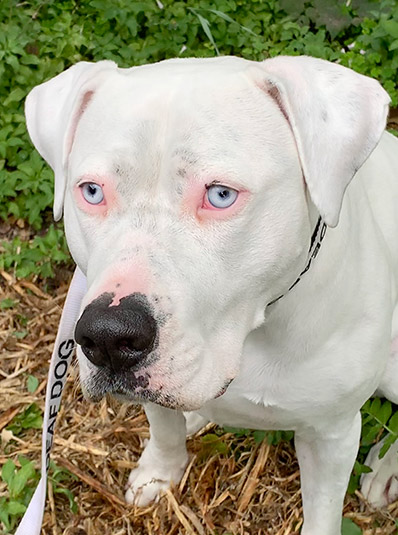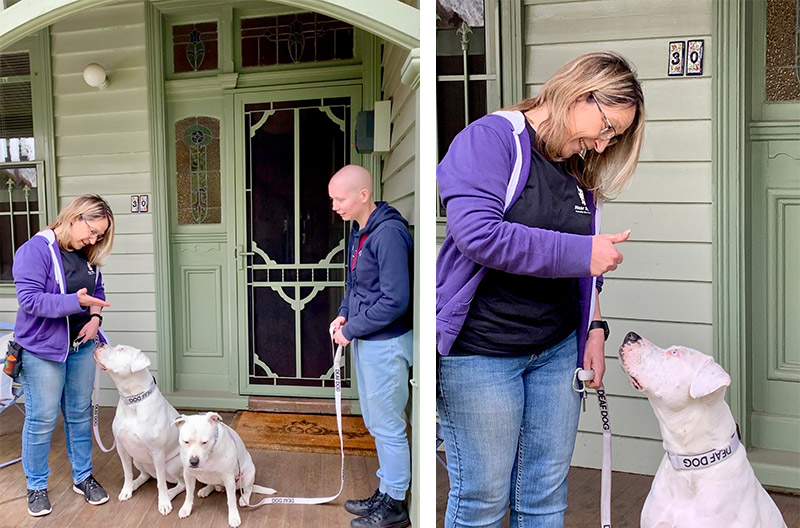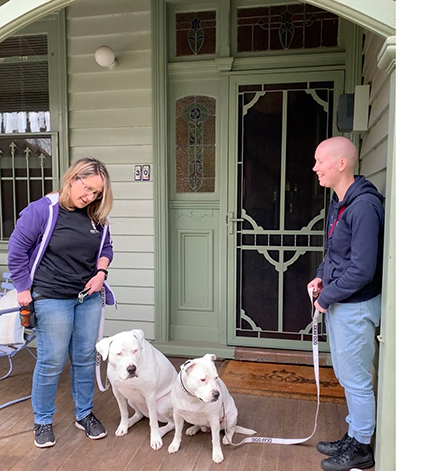
Hear No Evil – Australian Deaf Dog Rescue
Hear No Evil – Australian Deaf Dog Rescue is one of the most intriguing tales we’ve come across and one of the most dedicated. As the name implies, this rescue is for dogs that are hearing impaired, and there are far too many of them. LifeWise spoke to Hear No Evil’s Joanne Heyman and Katrina Leach about the situation and how this small in number, huge in commitment, body operates Australia wide.
As Paul Kelly and Kev Carmody sang to us, from big things little things grow. The organisation was started in 2014 by Sonja Coombes up in Townsville. She’d fostered special needs dogs for another group. Then came Kato. You could say he was the foundation canine member of Hear No Evil. His breeder, through no fault of her own – just bad luck – found herself with a deaf puppy in the litter and was reaching out to people who had experience and could help home him responsibly. As Sonja put it in email from Townsville, ‘Originally Kata was going to be the first of my ‘project’ dogs that I was going to train, fully vet, show off and use to change people’s minds about deaf dogs while I looked for the best forever home for him. Then the cheeky meathead weaselled his way into my heart so deeply it was glaringly obvious he was already in his forever home. What followed was the very start of Hear No Evil’.

Jo joined soon after and Hear No Evil now has volunteers and foster carers in every State and Territory except for the NT. This expansion has enabled them to gain charity status and over the last five years they’ve helped more than 150 challenged dogs find loving homes.
But it’s more than just collecting the dog and delivering it to a new foster or forever-home. The rescued dogs also undergo training that gives them and their future owners the tools by which they can build a harmonious relationship and enjoy a normal life despite their inherent handicap. There’s no tricks here; it’s basic action/reward training and each dog that goes to a new home has been socialised through the “I do. We do. You do” boot camp development as well as being de-sexed, microchipped and vaccinated.
The handicap, sadly, is inherent – and up to a point – avoidable. The condition is brought about by the introduction of a merle gene into the breeding line. The merle gene creates a mottled colour in the coat – as distinct from a solid or piebald colouration – and blue or odd coloured eyes. Driven by a market demand that is increasingly searching to make a distinctive statement, Kat and Jo believe some breeders are deliberately incorporating the merle gene into their breeding lines, thus spreading the anomaly beyond the limited group in which it was originally found: Great Danes, Dachshunds and the long-coated herding breeds.
The phenomenon, which only occurs in domestic dogs, would have occurred once in a common ancestor of the diverse breeds displaying the phenotype caused by the absence of skin pigment. However, it’s the deafness, and sometimes limitation of the dog’s vision that goes with the gene that is the tragic flow-on from this commercialisation of genetic science.

A classic example of the double merle gene showing the absence of pigment.
While a standard merle coated dog is quite normal in every way – even smarter than the average hound some might say – when two merles are crossed a double merle gene is created. The double merle animal has a high chance of being deaf, or blind, or both. Naturally the merle over merle cross creates more merle puppies, but only a DNA test will determine which of the 25% of the off-spring carry the double merle gene.
Jo said identifying a deaf dog as a puppy can be tricky. They don’t know they’re deaf so they take it in their stride in some respects. “Dogs are very intelligent and can compensate by developing a higher sense of smell and a more general alertness. Deafness is easy to establish if you look for it. Once you recognise what you’re looking for, the training is the usual repetitive exercises. You just replace oral commands with signals and touch. There’s nothing wrong with their intelligence. A lot of the time I’ll presume that Willow’s fast asleep, but as soon as I move she’s up and by my side”.
With so much at stake for the animals – who, let’s face it, have little control over who they mate with – we asked Jo and Kat if there was a concerted move among dog lovers, by encouraging responsible breeding, to try to weaken the influence – and potentially the elimination – of the double merle gene in the breeding population. “Good breeders, yes”, said Jo. “They understand the situation and the long-term implications. Others however, who put the dollars before animal welfare, say, well, there’s only a 25% chance of throwing a double merle. I’ll take those odds. They can be a bit elusive about how they sell their dogs as well, but reputable breeders will make sure that they don’t breed a dog that has a copy of the gene with another dog that also has a copy of the gene. A lot of the problem is really lack of education – amongst breeders and owners.
“However, the double merle gene is not the only cause of deafness, and sometimes it’s not bad breeding, just simply bad luck. It’s usually a lack of pigment where it’s needed – in the hair follicles in the ears – that causes deafness in white or merle dogs. It’s not something you can physically check as it’s the inner workings of the ear. Pups who lack pigmenting in general – of whom you suspect a hearing issue – can be BAER* tested if owners or breeders choose to check the exact hearing levels, but usually a ‘clap & whistle test’ of the pup is enough to confirm if the dog has a hearing problem.
Although it seems like a positive step, regulation is only part of the answer. “You can have two dogs registered with the council and you can claim that the mating was accidental”, said Kat. “They can breed whatever they like – whatever’s popular at the time – and sell the puppies for whatever they can get for them. The council has no control over those sorts of operations”.
Like most rescue groups, Hear No Evil rely on their social media pages for private surrenders who come in for a wide range of reasons; from council pounds; from other rescuers, who are aware of their special skills in this area also contribute to the intake; and of course, breeders who reach out for help. One of the biggest work strains in this area is the networking involved if they can’t find a home for a surrender or a death-row dog. Jo said that they, considering the strong presence of the merle gene in the stock herding breeds, and lately, the bull breeds, get a lot of calls from rural areas who find they have a deaf dog in their care.

First the command signal ‘Sit”… then the good girl Willow signal.
“People find deaf dogs difficult”, said Jo. “They don’t have the skills or patience to handle the special needs of these dogs and the animals find themselves in the too-hard basket. Some of course, have had extremely rough lives because of their deafness. Homing too, has its difficulties. It takes a special kind of person to have the understanding and persistence, but usually, once they meet the dog and see that they do have a quality of life – that they can understand the world around them – they find the place in their hearts for them, so much so that most of our foster trials finish up as adoptions”.
Evidence of their adaptability is their joy of playing with other dogs. Kat said, “All dogs, whether they can hear or not, love playing with other dogs. They learn to act on body language, which is just another indication of an adaptive compensation for their lack of hearing”.
Kat places a lot of emphasis on the dog’s ability to pick up on body language. “It’s important, and not just with deaf dogs, that your body language sends off the right signals. If you’re a bit down and give out stressed-out body language signals, they’re going to react to those negative signals. If you want them to be calm you have to be calm yourself and give off that relaxed body posture.
“Dogs most definitely take on the personality of their owners, and I’m sure they mirror the different people with whom they associate. I find myself minding Max quite a bit. I’m more of a quiet type and Max matches my personality when we’re together. But whenever he returns to his owner Kel, who is much more of an outgoing sort of person, Max’s excitement levels go through the roof”.
Funding for rescue groups is an ongoing administrative project and it’s no different at Hear No Evil. Donations – they have nearly 12,000 social media followers – and placements go towards the cost of micro-chipping, vaccination and other health issues and Jo explained they’d recently had a windfall. “Our local member down at Hastings, Neale Burgess, has supported us in an application for funding under an Animal Welfare Victoria program to assist with the de-sexing of double merle animals. We get quite a bit through donations. We find ourselves at markets or dog days just about once or twice a month; more in the warmer months. And then there’s the Dog Lovers’ Show – that’s enormous”.
No one has any illusions about how emotionally, as well as physically and financially taxing the rescue sector is. Kat said they’d spend hours a day answering messages from their website and social media pages and making phone calls. “These matters take time to deal with in a meaningful way. Some of them can be quite stressful dealing with owners who are digesting the fact that their cherished pet may have been coping with a hearing, or even a sight impediment, without them realising. Sonja handles an enormous amount of the workload, which entails not only surrenders, but also offering support, advice and training tips to other rescues and the general public on a regular basis. We don’t rely on social media as much as we rely on making connections in the real world, although a social media presence definitely helps raise funds and awareness.

Something in the breeze has caught the attention of Willow and Max’s super-sensitive sense of smell, much to Kat’s amusement and Jo’s frustration during an impromptu demonstration of signed commands.
“This only adds to the burnout rate for rescuers. Then there’re new layers of paperwork that we have to provide. Council registration numbers and the cost of having to re-register the dog for every foster transfer. The health certificates that have to be provided – proof of vaccination, de-sexing, microchipping – if you haven’t got everything up in the advertisement, the server has to immediately delete the post.
“You can’t sell a dog that’s not microchipped but people get away with it by saying they’re getting it done next week, and so on. Then, if you pass the dog on to someone else without them registering the change of ownership the dog effectively passes into limbo land.
“Just the other day we came across the case of a terrier that had been brought into the vet’s because of what happily turned out to be a benign tumour and when the vet checked the microchip it happened to be a dog that had gone missing 10 years ago. The person who brought it in had found the dog and taken a shine to it so he kept it. It wasn’t till the dog’s health deteriorated that he’d taken it to a vet, where the truth came out. So as much as you have regulations in place, if you want to get around them, for whatever reason, it’s pretty easy.
“In the meantime, we get loaded with all this extra paperwork. As if the job isn’t hard enough as it is. It’s driving people away from rescue work, and just when they’re most needed.”
It’s always heartening to sit down with members of one of the rescue groups that operate around Australia, although their stories can be as harrowing as they are alarming. In the case of Hear No Evil, it’s easy to see how the proliferation of the double merle gene throughout the breeding pool is placing an even greater load on the few people with the compassion and courage to tackle this issue. More strength to their arm.
Sonja, Joanne and Kat can all be contacted at
Email- [email protected]
Mobile – 0497 141 632 (Sonja)
Webpage – www.deafdogrescue.com.au
Facebook – @AustralianDeafDogRescue
Instagram – Hear_No_Evil_Australia
* Brainstem auditory evoked response (BAER) testing is an electro-diagnostic test used to evaluate the hearing of dogs, cats and other domestic animals. It evaluates the components of the external ear canal, middle/inner ear cavities, cranial nerve and selected areas of the brainstem. For further reading – https://www.ncbi.nlm.nih.gov/pmc/articles/PMC2643461/
